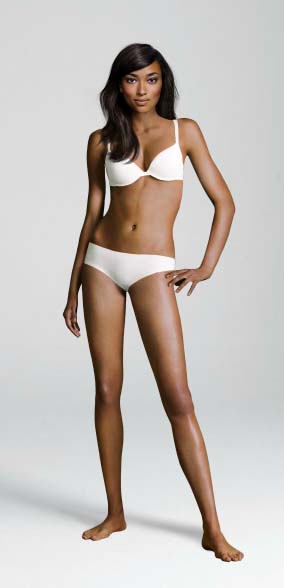Tamara Khandaker
Staff Writer
Over the past three decades, we’ve been conditioned by the fashion industry to accept thin, tall, and lean as the norm for women—anything less than perfect stands a very slim chance of meeting the public’s gaze.

Whether it is radically altering a model’s body the way Ralph Lauren did with Filippa Hamilton, or more recently, creating virtual bodies as H&M did on its website for a swimwear campaign, companies will stop at nothing to make sure their idea of “perfection” is drilled into our minds.
Strangely, it took days for anyone to even notice that the models on H&M’s website were identical. When placed beside each other, the photos are eerily similar. Every model stands in the exact same way, with the left hand positioned directly below the hip. They all have identical bony arms, protruding hips, and even the same belly button.
Upon the discovery by Swedish newspaper Aftonbladet, H&M’s admittance to having superimposed the heads of real models onto computer-generated bodies should have had us asking where to draw the line. Brushing it off is not an option.
As a retailer that markets to young women and girls, H&M’s campaign should have had us deeply offended. Basically, what the retailer is saying to us is that there is no model in real life that can sell its bikinis and underwear-—we are essentially not good enough to wear the company’s products.
Not only does it create completely unrealistic physical ideals, but the campaign could actually be considered downright deceptive. The pictures don’t allow us to see what the product looks like on an actual human. This defeats the whole purpose of displaying a product on any kind of body, and it would ultimately lead to a dissatisfied customer when they realize that the product looks nothing like it did on the “mannequins,” as H&M calls them.
But beyond that, it tricks women into believing that we can look like the woman in the poster if we buy the bikini she’s wearing and when that doesn’t happen, we blame ourselves, and some of us end up skipping breakfast, spending four hours at the gym on a diet of grapes and water.
Although it would be ideal, we can’t expect every company to take after Jacob, a Canadian retailer which has publicly committed to not Photoshopping its models in an effort to differentiate itself from other clothing companies.
With software now being developed by Dartmouth College which can detect how much a photo has been modified, we should follow Norway in taking the step to push for legislation that legally binds companies to put a disclaimer on advertisements whenever they have been digitally altered. Medical experts, advertising authorities, and legislators in Canada must take note of this and act fast because with the rise of fashion e-commerce, Extreme Photoshopping is here to stay, and sadly, the public doesn’t seem to care.


